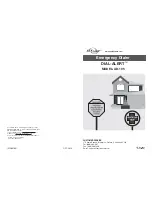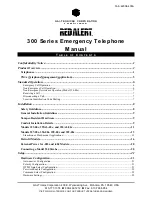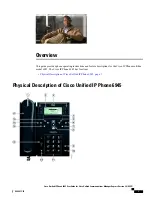
PHP400 GSM Help Point.
10
Take care when separating the 2 sections
– there are 4 cable sets between the 2 halves:
1. Induction loop audio (2 conductors)
2. DC power (2 conductors)
3. Earth cable
4. Antenna cable.
These cables are deliberately short, but will allow the front section to sit to the
left
of the rear
for set-up purposes if required.
4.6.
Installation method
The Help Point is intended for vertical installation to a solid wall or suitable post as detailed
below.
1. Choose a suitable location for the Help Point, bearing in mind the weight of the unit,
and that the operating button(s) should normally be in the range 1200
– 1400mm
from the ground for ease of access by people in wheelchairs.
2. Mark the wall or surface with fixing centres as shown above. If necessary use the
rear section to help mark the centres. Do not use the rear section as a drilling
template.
3. Select fixing screws or bolts appropriate to the type of wall or surface, suitable to
support the unit. Drill fixing holes to suit.
4. Separate the front and rear sections of the Help Point, taking care to disconnect
interconnecting cables as described in section 4.4.
5. Secure the rear section to the wall, making sure that the fixing holes are sealed to
prevent water ingress using nylon washers or other appropriate sealing methods.
6. Bring the power cable into the unit through one of the cable entry holes. Cables will
normally be contained in conduit, but glands may also be used.
7. The power cable is terminated directly to the terminal block provided, and secured
using the cable restraint.
Do not apply power until the SIM is fitted.
If necessary
remove the fuse to disconnect power until the SIM has been fitted.
8. Ensure that all cable entries are sealed to prevent water ingress. The blanking plugs
fitted to unused cable entry positions must be left in place.
9. Fit the SIM to the main GSM PCB in the front section as described below.
10. Connect induction loop audio, dc power, antenna and earth cables between the front
and rear sections of the case as shown below.
11. Apply power.
12. Configure and test the Help Point referring to the appropriate sections below.
13. Fit the front section over the rear section and secure in place using the 4 security
screws.
4.7.
Remote aerial.
Occasionally it may be necessary to site the aerial remotely from the Help Point either to
improve signal reception or to reduce the risk of vandal damage. For this reason the unit is
supplied with 3m of aerial cable, tied up inside the casing. In this case, disconnect the aerial
cable from the top of the GSM PCB, free the cable and unscrew the aerial itself from the
Help Point casing. The aerial has a 20mm threaded adapter which will allow it to be
mounted remotely up to 3m away, for example on conduit, and the cable fed back to the help
Содержание Help Point PHP400 GSM
Страница 33: ...PHP400 GSM Help Point 33 ...











































